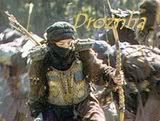username wrote:
The gondorians were obviously based on the late romans, with kind of a renaisssancy feel to them. All the other peoples had real world equivalents, easties+persians/parthians, haradrim=arabs/bedouin, rohirrim=saxons/visigoths, dunlendings=early germanic/gallic tribes(Cherusci, Iceni, Dacians, Quadi, Marcomanni, Iazyges, etc.) So, its perfectly obvious, that if they're based on late romans(who, by that time, used chainmail surcoats and only plate armor for limb protection) then they can have ballistas, and yes, even reapeating ones. Fact.
I agree. The repeating ballista was invented by Dionysius of Alexandria in the Roman Empire, and it was known as the "
polybolos" ("many bolts"). The large Isengard ballistae make sense for siege offensives, but for defending a wall or in a field battle the smaller Gondorian "bolt-throwers" make more historical sense. The late Roman Empire is known to have actually used
carroballistae ("ballista carts") in field battles - these were light ballistae mounted on carts that could be quickly moved to any point on the battle-field.
Ballistae were used on ships for many centuries; Julius Caesar is recorded as having mounted them on Roman warships when he tried to land on the beaches for his campaign in Britain. As the Roman Empire declined, however, the smaller
Manuballista ("hand ballista"), invented by Heron of Alexandria, became more widely used: it was cheaper to make, and evolved into the crossbow of the Middle Ages. Expensive ballistae were not as extensively used as previously, but they did survive as powerful naval weapons. In 1340, during the Hundred Years War, the Genoese galleys carrying troops to the Battle of Crécy are known to have carried 40 ballistae each.
Since New Line's Gondor seems based on a mix a Roman and Medieval Italian, it makes perfect historical sense that they have such ballistae. Personally, I use them in the following games, in order of precedence:
*Sea battles
*Sieges
*Field battles
 Top
Top Top
Top Top
Top Top
Top Top
Top Top
Top Top
Top Top
Top Top
Top Top
Top Top
Top
 ) to operate. Taking into account their points value, upgrades and other factors, to which are they more suited - field battles or sieges?
) to operate. Taking into account their points value, upgrades and other factors, to which are they more suited - field battles or sieges?
 )
)




